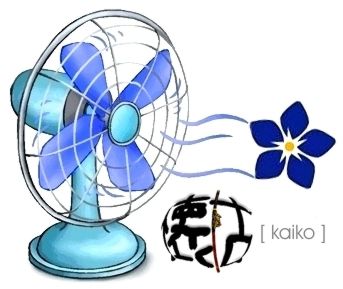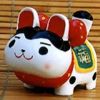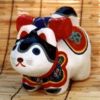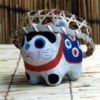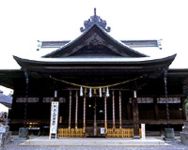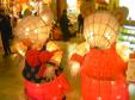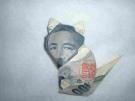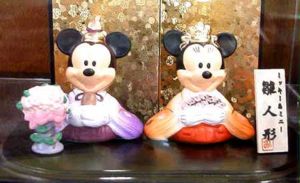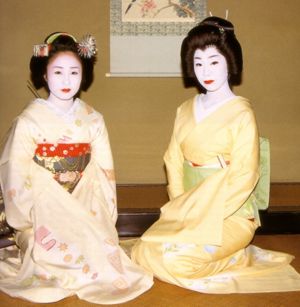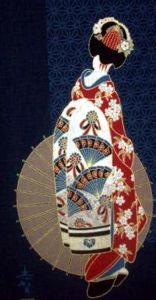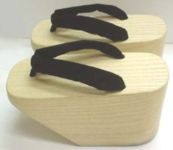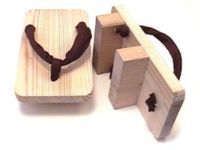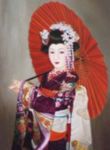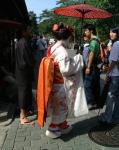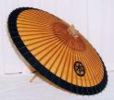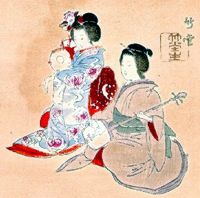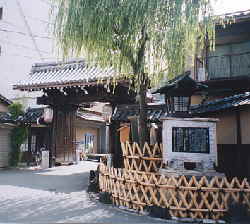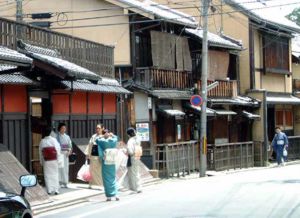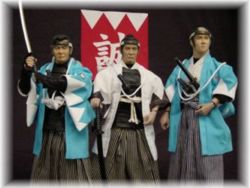INCIDENTS
OF REAL SAMURAI LIVES
LITTLE-KNOWN JAPANESE TRADITIONS
& SAMURAI TRIVIA
GUARDIAN
DOG
Too many Japanese stuff have been mistaken as toys or decorational pieces, while in fact they are lightyears away from how they look like. This is one of them, and this section deals with similar things. In the beginning of time (as far as these dogs are concerned), they were made of papier-mache in a district in Edo, the AKA of Tokyo in 1700's. Gradually all sorts of materials -- clay, cloth, porcelain, plastics, fiberglass -- have been the dogs' physical existence. The dogs' jobs are to get hung around babies' beds, as both their toys and protectors from the usual set of hazards, especially bad animal spirits and diseases. The dog often comes with a small drum or a basket, which are his toys. History of the dogs involves Kobo Daishi, 774-835 -- the Great Teacher (that's what 'daishi' means), founder of the Buddhist Shingon sect -- who once went to a pilgrimage in Shikoku and spent a night at a farmer's hut.
Since the host and hostess were exceedingly kind to him, Kobo asked them to name anything they wanted so he would be able to repay the hospitality before moving on. "Only an amulet or something, Your Grace," said the farmer; "we have been in the red because of bad harvests all these years -- our crops kept on getting devoured by wild boars, birds, and such." Kobo Daishi wrote something on a little piece of paper, then folded it intricately like only the Japanese knows how, and glued it with rice. This paper was then put at the entrance of the barn. That year, the farmer got a normal harvest (those days Japanese farmers only got one harvest annually), so did he the next year, and the next. This must have been the charm that Kobo Daishi gave him. After quenching his curiosity for so long, one day the farmer and his wife took the charm off, and opened the tightly-glued paper. A dog jumped out and ran and never came back, and the farmer got dragged back to his routine of facing a bad harvest since. How this brought the rest of the Japanese to end up with cute little guardian dogs for their babies, no one can tell; but such amulets were in circulation after that. What, anyway, did Kobo Daishi write on that piece of paper that started all that? Some said just plain and simple 'd-o-g' ('inu'), some others said he scribbled down the term 'inugami' -- which refers to something with more essential dogness than 'dog': 'spirit of a dog'. How could Kobo, despite his being Daishi, did that? Because he was an onmyoji. If you have watched the movie 'Onmyoji', you'd have seen the same feat done by the most famous Shinto (not Buddhist) priest in this solar system, Abe Seimei. Abe said it was the spirit of the paper instead of the critter created through it, but the result is pretty much the same thing. Kobo Daishi, since the time he was 'just' one of the best generic Buddhist priest named Kukai, was reportedly familiar with magic. His sect Shingon, established after he went back from China, favored 'the mysterious and the unexplainable in words', relying on mantras and rites which other sects don't do. Besides being one of the greatest Buddhists of Japan in all times, Kobo Daishi was also an accomplished calligrapher, painter, diplomat, inventor, author, and 'Yin and Yang Master' as I have mentioned before. You have been seeing one of Kobo Daishi's inventions everyday. It was he the inventor of the katakana, today's Japanese 'alphabet'. As for spirits of dogs, stay away from a movie titled Inugami (2003), directed by Harada Masato, starring Amami Yuki and Watabe Atsuro, if you have no stomach for such and such stuff, though the landscapic movie does very well in dishing out postcard-picture tranquility, albeit the horror movie genre it aspires to join. What stuff? This stuff: a mother in sex scenes with her son, who is a high school teacher, and who was born because of the mother's earlier sex scenes with her own brother. Then the mother and the son get married -- to each other. And they live happily ever after. There is also another 2003 horror movie that has been very successful in annoying people who watch it, titled Shikoku, about what would happen if you go on a Buddhist pilgrimage, including to Shikoku, in a reversed order. The Japanese Buddhist, as you might have known, don't just go to temples at random or make their own destinations in a pilgrimage; there has been a very clear scale of priority and a more or less exact list of which is to get visited after and before which. If you are in your own pilgrimage to animal shrines, drop by at the dog shrine in Shizuoka, the Yanahine:
This dog was deified because the people around the area believe that he was their savior. A long long time ago, so the story goes, the people there were haunted by a particularly nasty demon which demanded human flesh as food. The dog fought the demon and liberated the people from it.
|
THE
GOD'S RATS
'Nezumi' is a very nice name to call a girl by. Only it means 'rat' (that's the real thing on the last pic at your right). The Japanese respect this species, since it was a part of the animals in their almanac imported from China in 550's. It's also one of the Chinese zodiac signs.
Rats have been where they have been in Japan after the World War II. That, as you have known, was the final twilight of the samurai and the dawn of the economic mammals; everyone seemed to have agreed to nail money as the reason to live since. The early depictions of the Japanese God of Wealth, Daikoku, contained some rats munching the god's money bags. The pics were intended to remind people to watch over what they got; but in a fuzzy logic that has nearly been typical of Japan, rats are taken as symbols of wealth and financial luck from there on. 'Kibigara nezumi' is charms made of straw, like in the second pic above. This has been characteristic of the Tochigi area.
While the pic above is of some other excess of the so-called 'globalization'.
GOLDFISH
LANTERN
A warlord couldn't even breathe in the aftermath of the Meiji Restoration of 1868, let alone his low-ranked retainer. Emperor Meiji americanized everything. And since Abe Lincoln never knew warlords, His Majesty shouldn't, either. So castles were whacked down or put on sale, samuraihood was abolished, the feudal system was killed. One of around two million samurai at the time, an unfortunately nameless soldier of today's Yamaguchi prefecture, AKA the province of Nagato in 16th century, domain of the overlord clan of Mori, hit upon the idea of making paper lanterns shaped like goldfish one bleak day. He had a lot of reasons to do that. His kids were on the brink of starvation. His wife complained everyday of everything. His neighborhood was full of despairing ex-samurai and the collective grudge became more and more unbearable. Yet the same neighborhood was also full of bamboo groves; and hempen paper was easy enough for him to make, so were the 'paints' concocted of local herbs. A few days later, the Mori samurai went to the market and awkwardly offered his lanterns to passersby. He had never done anything like that before; and selling stuff was unthinkable just a few years earlier to most samurai, but now that was his only hope for survival. And he made it. Somehow people liked his lanterns. In just an hour or so he could get back home with some money. He made more lanterns the next day, and the next, and the next; those goldfish lanterns finally became all the rage and -- because there was no such a thing as copyrights -- other people imitated his design and sold their own goldfish lanterns. Why goldfish? Because this kind of fish is believed to be symbolizing the hoped-for prosperity. That notion was imported from China in 6th century. Such a life, but without the breakthru, is what was taken up onto the silverscreen by the actor Sanada Hiroyuki. The movie is titled Twilight Samurai (2003). Sanada got to make and sell bamboo cages for crickets there to prevent starvation, since his salary as a samurai was too small. Check it out. This movie is watchable despite the mercilessly bleak theme. |
THE
USUAL CONFUSION
At the left is a maiko. At the right is a geiko. 'Maiko' means 'girl dancer', and she used to be just that. The syllable 'gei' means 'art', so a 'geiko' should have been understood as 'female artist'. Together, they make 'geisha', or 'those who work in art'. But usually only geiko is meant when someone says 'geisha'. Maiko is an apprentice at the geisha house -- her job-description includes serving and running errands for the geiko. That's why all such women you've been seeing in Kyoto are not 'geisha' (geiko), but maiko. Geiko doesn't go out that often, and if she does go out she would be more likely to have no makeup on. Every geiko has a maiko, and vice versa; in the heyday of geishaism under the Tokugawa shogunate between 1700 and 1800, one geiko could have been a 'protector' of half a dozen maiko. How to tell which one is what? I don't expect you to remember the slight difference of the hairdo (though a Japanese might), but surely you can't forget that maiko has a lot on her head, literally (besides the huge wig -- yes, sir, that's not their own hair), while a geiko doesn't. A maiko's dress is always looking like too big for her (it really is, for that's the rule); a geiko's looks neatly her own size. A maiko's underwear ('nagajuban' in Japanese) is always bright, like scarlet with gold, while the geiko's is always plain and in pastels, usually salmon or the palest of pinks. The maiko's waistband (that thick and wide Tokugawanist 'obi') is always untied at the back, and let to flow down so that actually her entire appearance seems glamorously untidy. The geiko ties her waistband at the back like normal.
The materials that make the waistbands themselves are different -- the maiko's are always of virtually all colors on the palette, while the geiko's is softer. The maiko wears big and eye-catching jewels at the waist, the geiko doesn't. And the maiko is only allowed to wear these sandals that symbolize immaturity or teenage years:
O K O B O
While the geiko is entitled to wear these 'mature women's clogs':
G E T A
So now you know why the throng of 45 year-old American tourists who were posing for pix around Gion district in Kyoto in full 'traditional dress' of Japan look very scary. Beauty parlors plus photographers catering to this touristic need, since 1970's, have been lending out and making up maiko's outfit, not geiko's. And though, of course, they have never told any tourist the truth, the fact is the decidedly youthful dresses and hair ornaments surely can't get donned decently by anybody older than 15. A maiko nearly always appears with red umbrella and a fan, because those are her tools when dancing.
Oda Nobunaga's area in Gifu were known to be the source of leather-based armor ('domaru'), and paper and bamboo umbrellas that are called:
BANGASA
A geiko uses an umbrella if it's too hot or raining, but can't get associated with umbrellas like the maiko. What is readily associated with a geiko is 'shamisen', or the Japanese strings, which takes a long long time to learn to play, so that a maiko is obviously very lousy at it, while a geiko is usually a mistress of the art of stringwhanging.
All those rules were made by one of the innumerable tentacles of the Tokugawa shogunate based on the Japanese inimitable penchant for minimalism: the bejewelled, bright and glamorous maiko is not worth much; the understatedly-dressed geiko is the one worth coveted. Geiko and maiko live together with their landlady/manager in Kyoto's 'hanamachi' (literal: 'flowertown').
It's women's universe there, and even today the same old rules still apply. A geiko is an 'older sister' and a mentor of one or several maiko; she's responsible for bringing them up into passable geikos in the years to come. A maiko doesn't always grow into a geiko, you know. If she's too untalented the geiko will give her up and the landlady is going to kick her back to wherever she came from. If she is okay enough, the geiko will make a debut party to launch the maiko into the floating world, still as a maiko but now can entertain guests under the supervision of the geiko. Clients take her word on it -- if not for her name on the invite, they wouldn't even bother to show up. Since mid 1700's, the Tokugawas let geisha to have 'family' crests. All maikos use the crest of the house, while geikos were allowed to use their very own crests (individual crests that were not related to any family).
You must have seen the Kyotoite 'hanamachi' too many times in the movies -- and it is always featured in movies that take the Shinsengumi (1853-1869) as the theme, because that's where this band of Tokugawaist urban slashers spent their entire salaries at.
Other than in Kyoto, there has never been a maiko. Why would anybody still come to 'hanamachi' to be a maiko in 21st century? Some still come to run away from problems at home, some still come for the money, some do for the 'love of arts', some for fame, some for the inexistence of other sanctuary. The only ancient reasons that are no more in vogue are that the girl was kidnapped or sold to the establishment by her own dad.
|
| Previous | Next |
PAGES OF LITTLE-KNOWN JAPANESE FACTS & LITTLE THINGS ABOUT JAPANESE SAMURAI
| 01 | 02 | 03 | 04 | 05 | 06 | 07 | 08 | 09 | 10 | 11 | 12 | 13 | 14 | 15 | 16 | 17 | 18 | 19 | 20 |
| 21 | 22 | 23 | 24 | 25 | 26 | 27 | 28 | 29 | 30 | 31 | 32 | 33 | 34 | 35 | 36 | 37 | 38 | 39 | 40 |
| 41 | 42 | 43 | 44 | 45 | 46 | 47 | 48 | 49 | 50 | 51 | 52 | 53 | 54 | 55 | 56 | 57 | 58 | 59 | 60 |
|
Site & Rap © 1996, 1997, 1998, 1999, 2000, 2001, 2002, 2003, 2004, 2005, 2006 Nina Wilhemina
Pictures for this section
are compiled by Obata Sugizo, Ryoku Nakane, Hasegawa Tomoko, Asada Kanae,
Matt Emery, Arisugawa Takashi, Sandy McClelland, James Kwan, Richard Rock,
Mary B. Morton, and Zui Rena
All rights reserved. Every borrowed image at this site is put for non-profit educational purposes only.
HOME
 LINKS
LINKS
 CONTACT
CONTACT
 CREDITS
CREDITS
 COMMENTS
COMMENTS
